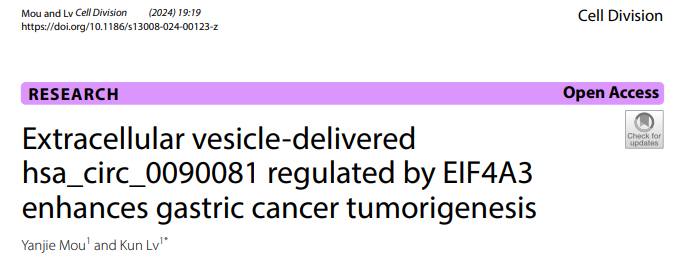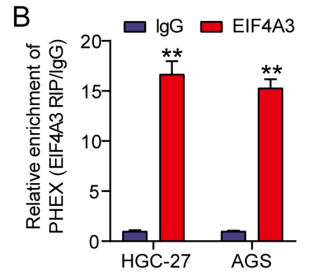Toggle Navigation
Time of publication:June,2024

Summary
Background: Circular RNA (circRNA) and extracellular vesicles (EVs) in tumors are crucial for the malignant phenotype of tumor cells. Nevertheless, the mechanisms and clinical effects of EV-delivered hsa_circ_0090081 in gastric cancer (GC) are unclear. This study aimed to reveal the effect of eukaryotic translation initiation factor 4A3 (EIF4A3)-mediated hsa_circ_0090081 expression and EV-delivered hsa_circ_0090081 on GC progression.
Methods: qRT-PCR was conducted to clarify hsa_circ_0090081 and EIF4A3 levels in GC tissues. Transmission electronic microscopy (TEM), nanoparticle tracking analysis (NTA), and Western blotting identified the EVs isolated from GC cells by ultracentrifugation. The roles of hsa_circ_0090081, EIF4A3, and EV-delivered hsa_circ_0090081 in GC cells were analyzed using Transwell, EdU, and CCK-8 assays. The regulatory role between EIF4A3 and hsa_circ_0090081 was investigated using RIP, qRT-PCR, and Pearson's analysis.
Results: Our study showed that hsa_circ_0090081 and EIF4A3 were highly expressed in GC, and hsa_circ_0090081 was associated with poor prognosis. Data revealed that hsa_circ_0090081 inhibition restrained GC cell proliferation, invasion, and migration. Additionally, EIF4A3 could bind to the pre-mRNA of PHEX (linear form of hsa_circ_0090081) to enhance hsa_circ_0090081 expression in GC cells. Moreover, EIF4A3 overexpression nullified the malignant phenotypic suppression caused by hsa_circ_0090081 silencing in GC cells. Furthermore, EVs secreted by GC cells delivered hsa_circ_0090081 to facilitate the malignant progression of targeted GC cells.
Conclusion: This study showed that hsa_circ_0090081 was enhanced by EIF4A3 to play a promotive role in GC development. The results may help understand the mechanism of EIF4A3 and EV-delivered hsa_circ_0090081 and offer a valuable GC therapeutic target.


BersinbioTM cooperative technology:RIP
Original link:10.1186/s13008-024-00123-z